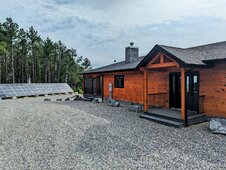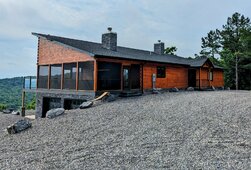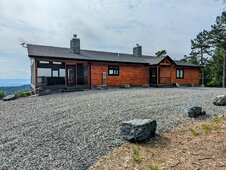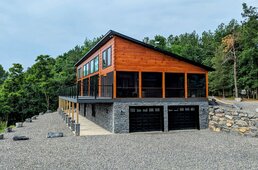Hey everyone,
Two years ago, I had a vision to build a cabin in West Virginia. I bought 20 acres of land and started planning and designing the cabin. I told my wife at the time that we had an amazing opportunity that we've never had before where we can actually stop coal from needing to be burned in the state most known for mining and burning coal. My wife and I decided to power the cabin purely on solar, and then I found this forum and was able to learn sooooo much throughout that year. I went from knowing nothing about solar to being able to build a fully-functioning solar installation which powers the whole cabin where everything inside is electric. I decided to use the grid as a backup, and so got a utility connection input. Originally I was planning for the cabin to be fully off-grid, but I didn't realize at the time how a fully electric cabin plus winter is a recipe for omg so much expensive. I would probably need 50% more panels, along with at least 2-3x more battery storage (120+kWh rather than the 63kWh I have now) in order to fully get through the winters. Electric heating is pretty terrible when it's 0deg outside. I initially got a quote from a solar installer to do the work for the same size and battery capacity that I ended up building myself, and their quote was $120,000

 . For comparison's sake, the total cost for all my solar components after the tax credit was $27,470.
. For comparison's sake, the total cost for all my solar components after the tax credit was $27,470.
The cabin is a second home to visit on weekends or holidays, or where I can work from for a week or two at a time where I need to focus and want the peace of nature as a backdrop. While we're not there, the cabin uses very little power, and I wanted to be able to sell the excess back to the utility. After months of navigating the bureaucracy and paperwork, I just today got my ATO and I'm officially able to export power to the grid (just in time for all the summer sunny days!) and bank credits for the winter time. Because this forum helped me understand how to do everything properly, to code, I didn't have to make any changes to my setup at all; it passed engineering review and inspection on the first try. I anticipate that I'll be able to produce way more power than the cabin could ever realistically consume, and I wanted to thank this forum and all of the DIY contributors who have helped make my journey a resounding success. You've all made a massively positive impact in my life in helping me realize my vision of an all-electric cabin in the mountains of West Virginia.
THANK YOU!
Two years ago, I had a vision to build a cabin in West Virginia. I bought 20 acres of land and started planning and designing the cabin. I told my wife at the time that we had an amazing opportunity that we've never had before where we can actually stop coal from needing to be burned in the state most known for mining and burning coal. My wife and I decided to power the cabin purely on solar, and then I found this forum and was able to learn sooooo much throughout that year. I went from knowing nothing about solar to being able to build a fully-functioning solar installation which powers the whole cabin where everything inside is electric. I decided to use the grid as a backup, and so got a utility connection input. Originally I was planning for the cabin to be fully off-grid, but I didn't realize at the time how a fully electric cabin plus winter is a recipe for omg so much expensive. I would probably need 50% more panels, along with at least 2-3x more battery storage (120+kWh rather than the 63kWh I have now) in order to fully get through the winters. Electric heating is pretty terrible when it's 0deg outside. I initially got a quote from a solar installer to do the work for the same size and battery capacity that I ended up building myself, and their quote was $120,000
The cabin is a second home to visit on weekends or holidays, or where I can work from for a week or two at a time where I need to focus and want the peace of nature as a backdrop. While we're not there, the cabin uses very little power, and I wanted to be able to sell the excess back to the utility. After months of navigating the bureaucracy and paperwork, I just today got my ATO and I'm officially able to export power to the grid (just in time for all the summer sunny days!) and bank credits for the winter time. Because this forum helped me understand how to do everything properly, to code, I didn't have to make any changes to my setup at all; it passed engineering review and inspection on the first try. I anticipate that I'll be able to produce way more power than the cabin could ever realistically consume, and I wanted to thank this forum and all of the DIY contributors who have helped make my journey a resounding success. You've all made a massively positive impact in my life in helping me realize my vision of an all-electric cabin in the mountains of West Virginia.
THANK YOU!










